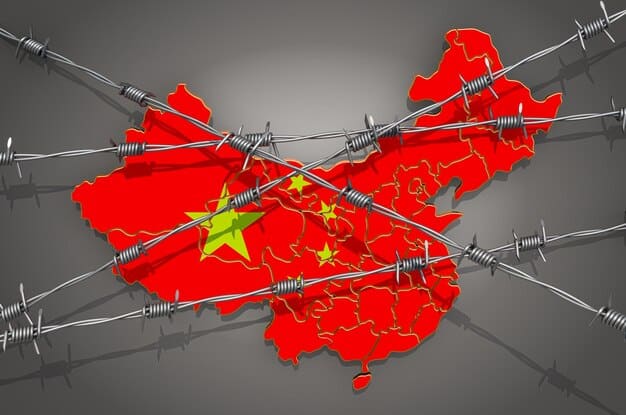The Vietnam War: Uncovering Tet Offensive Strategies

The Vietnam War’s Tet Offensive, launched in 1968, was a series of surprise attacks by the Viet Cong and North Vietnamese forces, aimed at key strategic targets in South Vietnam, altering the course and perception of the war.
The Vietnam War: Uncovering the Strategies Behind the Tet Offensive reveals a pivotal moment in military history. This offensive dramatically shifted the conflict’s trajectory, leaving an enduring impact on both sides.
Background to the Tet Offensive
The Tet Offensive, a turning point in the Vietnam War, requires a deep dive into its historical context. Understanding the events that led to this offensive is crucial to grasping its significance.
Escalation of U.S. Involvement
U.S. involvement in Vietnam steadily increased throughout the 1960s. This escalation was driven by the domino theory and the desire to contain communism.
The Gulf of Tonkin incident in 1964 was a key event that led to increased U.S. military presence in Vietnam.
North Vietnamese Strategy
North Vietnam’s strategy aimed to unify the country under communist rule. This involved guerilla warfare and political maneuvering.
Ho Chi Minh’s leadership and the Viet Cong’s insurgency were central to this strategy. Their persistence challenged U.S. and South Vietnamese forces.
- Political goals in Vietnam were unification under communist control.
- Military Strategies included guerilla tactics and protracted warfare.
- Logistical support came from the Ho Chi Minh Trail, evading detection.
By understanding the background, the boldness and impact of the Tet Offensive become clearer. It was a strategic gamble with profound consequences for all involved.

Planning and Objectives of the Offensive
The Tet Offensive’s planning was meticulous, with clear objectives set by North Vietnamese leaders. Their audacious plan aimed to strike at the heart of South Vietnam.
Deception and Surprise
A key aspect of the Tet Offensive was the element of surprise. The North Vietnamese successfully concealed their plans, catching the U.S. and South Vietnamese forces off guard.
Attacking during the Tet holiday was a calculated move, as it was a time of traditional truce and reduced vigilance.
Military and Political Goals
The offensive had both military and political goals. Militarily, it aimed to inflict heavy losses on the enemy. Politically, it sought to spark a popular uprising and force the U.S. to negotiate.
Weakening the Saigon government and demonstrating the war’s unsustainability to the American public were crucial political objectives.
- To trigger a general uprising among the South Vietnamese population.
- To demonstrate the Saigon government’s weakness and instability.
- To undermine U.S. public support for the war.
The strategic boldness of the Tet Offensive reveals the determination of the North Vietnamese leadership. Their detailed planning and clear objectives set the stage for a pivotal moment in the war.
The Initial Attacks and Key Battles
The Tet Offensive unfolded with a series of coordinated attacks across South Vietnam. Several key battles would define the offensive’s intensity and outcome.
Saigon Assault
The assault on Saigon, the capital of South Vietnam, was a bold move that shocked the world. Viet Cong forces targeted key installations, including the U.S. embassy.
Although the attacks were eventually repelled, they demonstrated the vulnerability of the South Vietnamese government.
Hue City Battle
The battle for Hue City was one of the longest and bloodiest battles of the Tet Offensive. Viet Cong and North Vietnamese forces seized control of the city and held it for weeks.
The fighting was intense, with both sides suffering heavy casualties. The battle also resulted in significant destruction of the city.
- The attack in Saigon targeted symbols of American influence.
- The battle for Hue resulted in severe urban warfare.
- Khe Sanh served as a diversion to draw US forces away from urban centers.
From Saigon to Hue, the initial attacks revealed the offensive’s widespread impact. These battles underscored the war’s brutality and the North Vietnamese forces’ determination.

U.S. and South Vietnamese Response
The U.S. and South Vietnamese forces faced a formidable challenge in responding to the Tet Offensive. Their initial reaction was one of shock, but they quickly mobilized to counter the attacks.
Counteroffensive Strategies
The U.S. military employed a range of counteroffensive strategies, including air power and ground assaults. They aimed to dislodge the Viet Cong and North Vietnamese forces from the captured areas.
The counteroffensive was costly, but it eventually succeeded in pushing back the enemy.
Impact on Military Morale
The Tet Offensive had a significant impact on military morale. While the U.S. and South Vietnamese forces were ultimately successful in repelling the attacks, the offensive exposed vulnerabilities and raised questions about the war’s progress.
Many soldiers and officers began to question the optimistic assessments of the war’s leaders.
- Rapid deployment of troops to key areas under attack..
- Increased use of air power to support ground operations.
- Coordination between U.S. and South Vietnamese forces.
The response of the U.S. and South Vietnamese forces reveals the resilience and adaptability required to face a determined enemy. However, the Tet Offensive left lasting scars on both the military and the public.
Media Coverage and Public Opinion
Media coverage of the Tet Offensive played a crucial role in shaping public opinion about the Vietnam War. The images and stories that emerged from the offensive challenged the narrative of progress and victory.
Shifting Narrative
The Tet Offensive exposed the credibility gap between the official government reports and the reality on the ground. The media began to question the optimistic assessments of the war’s leaders.
The public grew increasingly skeptical of the war’s purpose and prospects.
Anti-War Movement
The Tet Offensive galvanized the anti-war movement in the United States. Protests and demonstrations grew in size and intensity, putting pressure on the government to end the war.
The offensive also led to increased political polarization, with some Americans supporting the war and others calling for immediate withdrawal.
- Graphic images of combat appeared on television.
- Investigative journalism exposed the war’s complexities.
- Public debates questioned the war’s morality.
The media coverage and shifting public opinion highlight the power of information in shaping the course of history. The Tet Offensive became a symbol of the war’s futility and the government’s missteps.
Long-Term Consequences and Legacy
The Tet Offensive had profound long-term consequences and a lasting legacy. It altered the course of the Vietnam War and reshaped American foreign policy.
Political Fallout
The Tet Offensive led to significant political fallout in the United States. President Lyndon B. Johnson’s popularity plummeted, and he eventually decided not to seek re-election.
The offensive also contributed to the sense of disillusionment and cynicism that characterized American politics in the late 1960s.
Impact on Vietnam War’s Outcome
The Tet Offensive ultimately contributed to the U.S. withdrawal from Vietnam. While the U.S. and South Vietnamese forces successfully repelled the attacks, the offensive demonstrated the war’s unsustainability and the determination of the North Vietnamese.
The war continued for several more years, but the Tet Offensive marked a turning point in the conflict.
- Increased distrust in government.
- Shift in U.S. foreign policy.
- Lasting impact on Vietnam.
The long-term consequences and legacy of the Tet Offensive reveal its lasting impact on both the United States and Vietnam. It serves as a reminder of the complexities and costs of war.
| Key Point | Brief Description |
|---|---|
| 🎯 Surprise Attacks | Viet Cong and NVA launched widespread assaults. |
| 📰 Media Impact | Coverage shifted public opinion against the war. |
| 💔 Political Fallout | LBJ’s popularity declined, led to policy changes. |
| 🔄 Strategic Shift | Changed war’s course, led to US withdrawal. |
Frequently Asked Questions
▼
The primary goal was to incite a popular uprising in South Vietnam, destabilize the government, and force the U.S. to negotiate a withdrawal from the war.
▼
The Tet holiday was traditionally a time of truce and reduced military activity. This created an element of surprise and caught the U.S. and South Vietnamese forces off guard.
▼
It significantly eroded public support for the war. Media coverage exposed the war’s brutalities, increasing the credibility gap between government reports and on-the-ground realities.
▼
Key targets included Saigon, the capital of South Vietnam, and Hue, which experienced some of the most intense and prolonged fighting of the offensive.
▼
It revealed the unsustainability of the war to the American public. Increased pressure on the government fostered conditions that ultimately led to U.S. withdrawal and subsequent events.
Conclusion
In conclusion, the Vietnam War: Uncovering the Strategies Behind the Tet Offensive highlights a critical juncture in the conflict. The offensive’s strategic planning, initial attacks, and long-term consequences reshaped the war’s trajectory, leaving a lasting impact on both military and political landscapes involved.





